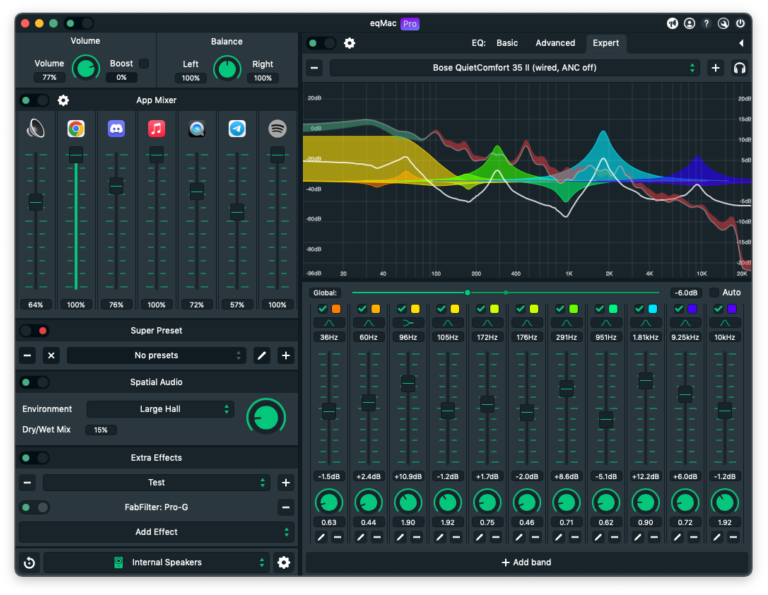For my birthday, I got a new pair of speakers for my home office / home studio. After looking around for quite some time, I settled on the ADAM Audio T5V in the end. The T5Vs are affordable, entry-level studio monitors with a 5“ woofer that are optimized for smaller rooms. And it doesn’t make sense to blast much more bass into my 3 by 3 meter office anyway. I’m still far from being experienced when it comes to judging the sound quality coming out of professional speakers, but I wanted something that would allow me to reliably judge occasional (and soon more frequent?) audio recordings. A first listen confirmed the many positive reviews I watched and read: connected to the MOTU M2 via balanced XLR, and without having had the time to properly burn them in yet, the T5Vs still produced an impressively clear, rich, and powerful sound.
Looking at the frequency response curve of the speakers, you’ll see that they in fact have a relatively flat response curve, which means that neither the lows (the “bass”) nor the mids are too pronounced. There seems to be a little boost in the higher frequencies above 5 kHz but this can probably be adjusted via a switch on the back.

A flat frequency response is exactly what we want when the goal is to assess and master audio recordings, but of course, I also want to use the speakers to listen to music of all genres. From Run the Jewels, MF DOOM (all caps when you spell the man name), or Kendrick to The Strokes, the Arctic Monkeys, or David Bowie to Portishead, DJ Krush, Max Richter, Hans Zimmer’s Dune, or Beethoven played by the Vienna Philharmonic or Igor Levit. And that’s when you realize you need some equalization.
Thus far, I’d been mostly using headphones while at work and whenever I wanted to slightly adjust the sound, I opened a little app called eqMac. But I also recently switched to the more analytical sounding Austrian Audio Hi-X60 which had already increased my appetite for a proper solution for EQing my Macs audio output.
Last but not least, equalization can be useful to compensate for problematic resonances or other characteristics of your room. But thus far, I’ve not entered those spheres (yet).
EQing Mac System Audio
There are a few ways you can use equalization on the Mac. First, you could use the built-in equalizer of Spotify or any other music app. In the case of Spotify though, I got horrifying results. I don’t know what they do but it destroyed the signal completely and introduced crackles and clipping.
Then, there are a few apps that adjust the output of your Mac’s system audio and sometimes also let you add effects, like eqMac, Sound Control, or Boom 2. My experience using eqMac, which comes with a free and a pro version, was fine overall. It allowed me to make quick basic adjustments, but it was also annoying at times, especially because I regularly had to start it twice (?) until it finally opened or when the EQ settings quickly lead to clipping audio.

So I had another look around, and the most promising app, which also a few people suggested on Mastodon, is SoundSource by Rogue Amoeba. Rogue Amoeba are also the creators of LoopBack, an ingenious and indispensable tool for routing and combining different audio signals and outputs, especially when you are running online workshops or streaming sessions.
SoundSource lives in your menu bar and lets you not only adjust the volume of your system audio, but also individually for each of the running applications. You can adjust the audio with a 10-band equalizer, again both system-wide as well as on a per-app basis, and much more. What really sets SoundSource apart and convinced me in the end, though, are two more effects: the headphone EQ effect allows you to automatically equalize and tailor the sound to your specific headphone model. You can pick from thousands of presets and also add your own.

The second killer feature is support for Audio Units, Apple’s system-level plug-in architecture for Core Audio. What this basically means is that you can use all the free or paid plugins that you can use in audio workstations – like Logic Pro, Audition, Pro Tools, Reaper, Ableton Live, or PreSonus Studio One – to adjust your system audio, too.
And suddenly, the possibilities for equalization on the Mac seem endless. Just look at this list of only a few popular EQ plugins:
- FabFilter Pro-Q 3
- iZotope Neutron
- okesound soothe2
- Soundtheory Gullfoss
- TDR Nova
- TDR VOS SlickEQ
- Ignite Amps PTEq-X
- Luftikus
- Sonimus SonEQ
In my case, this means I can use iZotope Nectar 3 Elements, for example:

And who knows, maybe I’ll soon actually adjust for all the weird resonances in here…
What do you use to adjust the audio on your Mac or in your room? What are your favorite plugins? Let me know via Webmention, Mastodon, email, or in a response blog post.
~











